Garden Designers Roundtable: Getting From Here to There – Garden Paths Lead the Way
Remember that old joke about the farmer who tells the lost traveler, “You can’t get there from here”? Do you ever feel that way about your yard or garden? Does nothing invite you in or show you where to go?
If your yard has a bad case of the do-not-enters, take heart! This condition is easily remedied with a little thoughtful planning. Here are my 7 tips for “getting from here to there” in the garden, this month’s topic at Garden Designers Roundtable.
1. Only kids and dogs like to walk across the lawn. OK, this is a generalization—I know you barefooters love the feel of grass under your toes—but I believe it’s true of most people. Have you noticed how visitors will stop on your patio or deck and just look out at the rest of your garden, but not actually venture into it, if the only access is the lawn? And have you ever visited (or do you own) a house that lacks a sidewalk from the street to the front door? Either you have to traipse all the way up the driveway, squeezing past the family sedan, to reach a tiny, L-shaped walk to the door, or you have to hike cross-country over the lawn. Not welcoming.
Solution? Invite people in with a clearly defined path. In front this can be quite broad—a width of 5 or 6 feet allows two people to walk up side-by-side. In back, a narrower path may do, but make sure it’s visible and easily accessible from your back steps or patio, not hidden behind the outdoor dining set.
2. Put a path where you want people to go. This advice may seem patently obvious, but you’d be surprised how often it’s overlooked.
Solution? Consider the destination points in your yard or garden—shady seating area? swing set? hammock?—and run paths to them. You can make them curvy and leisurely or take the most direct line. But give people a way to get there. Build it and they will come!
3. Don’t neglect the necessities. We’ve all got garbage and recycling bins to haul around, compost piles to tend, and storage places for pots, bags of soil, and the odd, broken trellis we mean to mend. Usually these are tucked away in side yards or some other neglected, semi-hidden part of the garden. Maybe you have to drag your garbage bin, lurching and tilting, across a shaggy lawn to get it to the curb. Maybe you have to scythe your way through an overgrown cosmos jungle to add your child’s uneaten vegetables to the compost bin.
Solution? Do yourself a favor, and build a functional path to make the business end of the garden run smoothly. Run a packed gravel path from the side yard to the driveway to get those bins in and out. Dedicate a comfortable stepping-stone path from the kitchen door to the compost pile. Spread a broad mulched path in a tree-shaded work area, and keep the mulch replenished as needed.
4. Make a closed circuit. This is electrical talk for creating pathways that allow unimpeded flow through the garden—an endless loop, as it were. I like this in a house’s layout too, but that’s another story. A “closed circuit” garden is one in which you can walk guests out your front door, around to one side of the house, into and through the back yard, out the other side yard, and back to the front door by following a series of paths or other hardscaped (paved) areas, with no break where you have to travel cross-country across grass or mud or find your way blocked by a gate-less fence.
Solution? Visualize the natural paths around your home, and install paths to get you from one point to the next. Maybe a decomposed-granite path would work out front, running perpendicular to the main walk over to the side-yard gate. A stepping-stone path might continue the loop through the side yard and lead to the concrete patio out back. Add a generous decomposed-granite “apron” all around the edge of your patio to make it more spacious (builders’ patios are inevitably too small), and run paths from here to the shed or the kids’ playscape. (Just think about all the thirsty grass you can remove by laying generous paths through your yard!) More stepping stones might lead from the patio to the other side yard and continue around to the front of the house and your front walk. Voila!—a closed circuit that provides an endless loop and an open invitation to explore all parts of the garden.
5. Add mystery with secondary paths. These are the sometimes secret little paths discovered in the process of exploring a garden. They are an enticement. They beckon you to take the road less traveled, a little grassy and wanting wear. Where other paths are meant to be visible and easily traversed, the secondary path is more frivolous. It may offer a narrow track through the daylilies, lead around a large shrub or bushy tree…to who knows what? There’s only one way to find out.
Solution? Once your main paths are in place, give some thought to smaller, more leisurely paths that lead to hidden or interesting points in the garden. Woodsy gardens especially lend themselves to this approach because you can’t see everything all at once. But even in a sunny garden you can create a sense of mystery and exploration by obscuring an open view with a strategically placed ornamental tree or clump of grasses, and wind a little path beyond them. Give the traveler a pay-off with a pretty view that only becomes apparent along the way, or make your own view with a striking garden ornament: a large urn, bubbling fountain, statue, or focal-point plant.
6. Include access paths for maintenance. Let’s say you’ve converted a large section of your yard into garden, and you thoughtfully ran a gravel path through it for your visitors (and yourself) to admire the view. After one good rain, however, you notice a crop of weeds coming up in your new beds, and with 8 or 10 feet of garden on either side of the path you find you can’t reach them. Not unless you clomp in, compacting your fluffy, new soil and stepping on a few baby plants in the process.
Solution? Rather than tromping across your freshly planted beds to pull weeds or trim plants, simply include a few narrow access paths through your new garden for necessary maintenance. A handful of well-placed stepping stones will usually do the trick, and even if foliage eventually hides them from view, you’ll know where they are and can use your maintenance paths as needed to keep the garden in order.
7. Walk your paths daily! Once your paths are in place, you will find an open invitation into your garden every time you step outside. Steal a moment or two in the garden with your cup of coffee before work, or stroll the paths by moonlight when you get home. Explore them with your family or friends on the weekend. Like neighborhood sidewalks, garden paths give you a reason to get out there and see what’s happening—what’s blooming or going to seed, what the butterflies or bees are enjoying, what needs a little attention, what’s doing great on its own. You may find you use your patio chairs a lot less but enjoy the garden a lot more.
For more perspectives on “Getting from Here to There,” please visit the posts of my fellow Roundtablers and our special guests, Debra Prinzing and David Perry. Links to all the posts are listed below and can also be found at Garden Designers Roundtable. Happy reading!
Debra Prinzing & David Perry : A Fresh Bouquet
Pam Penick : Digging : Austin, TX
Scott Hokunson : Blue Heron Landscapes : Granby, CT
Rebecca Sweet : Gossip In The Garden : Los Altos, CA
Jenny Peterson : J Peterson Garden Design : Austin TX
Susan Cohan : Miss Rumphius’ Rules : Chatham, NJ
Susan Morrison : Blue Planet Garden Blog : East Bay, CA
Jocelyn Chilvers : The Art Garden : Denver, CO
Lesley Hegarty & Robert Webber : Hegarty Webber Partnership : Bristol, UK
Christina Salwitz : Personal Garden Coach : Renton, WA
All material © 2006-2011 by Pam Penick for Digging. Unauthorized reproduction prohibited.


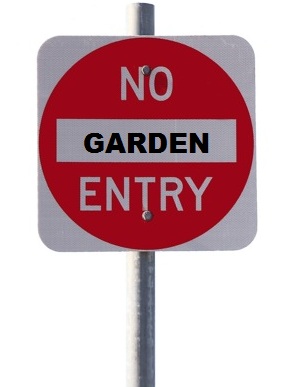
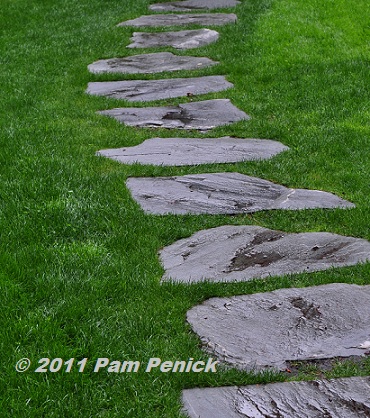
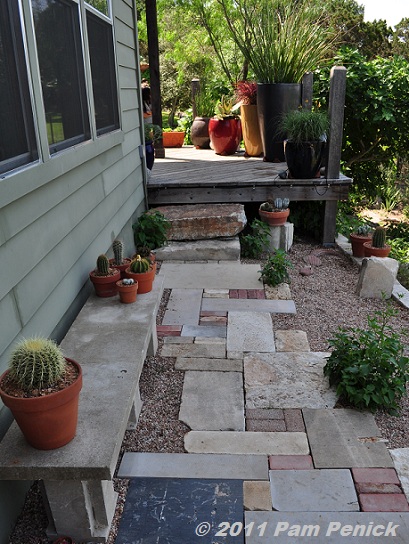
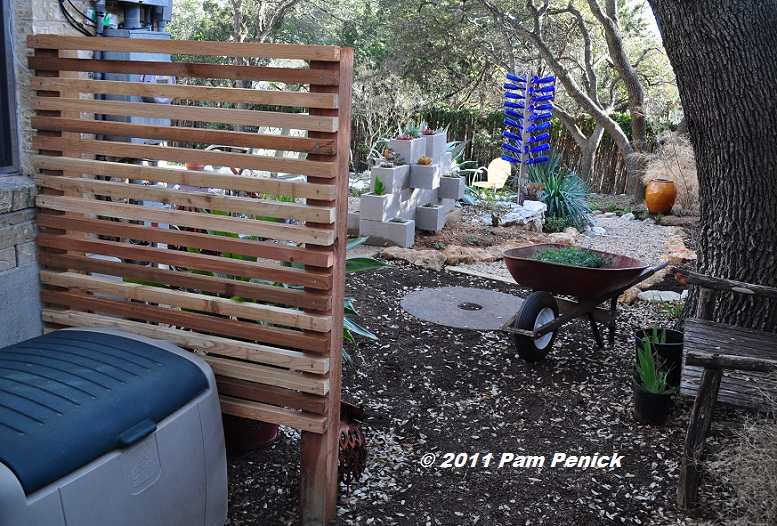
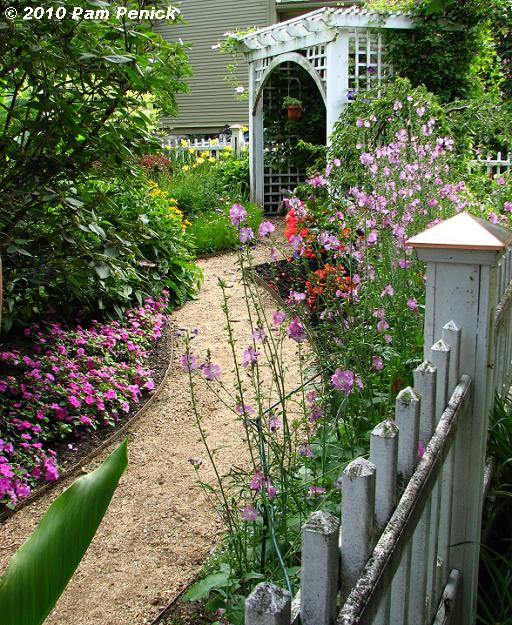
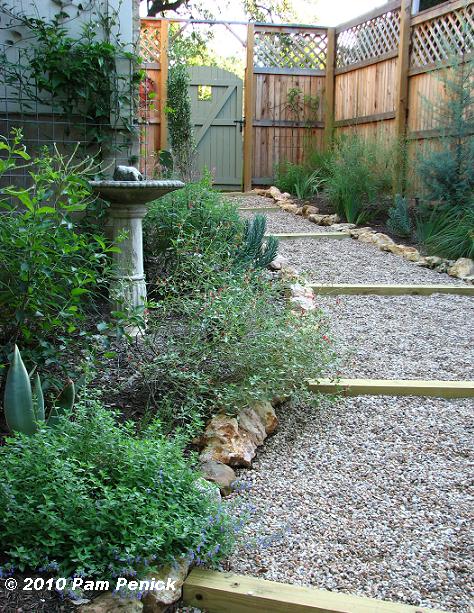
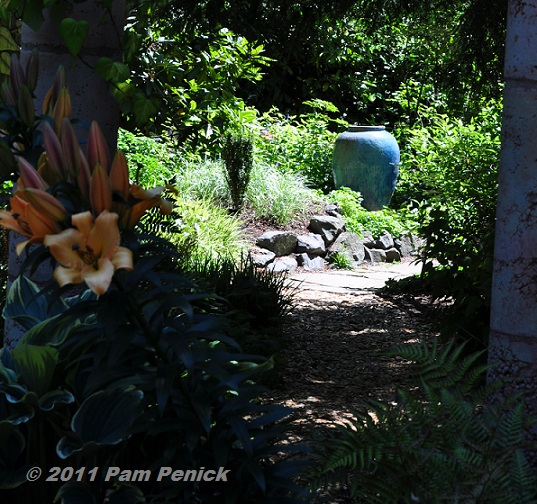
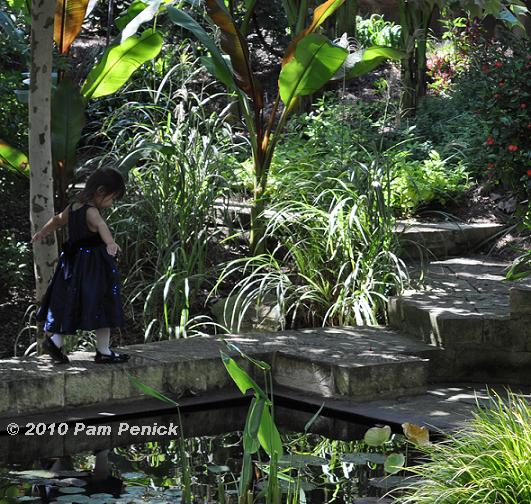
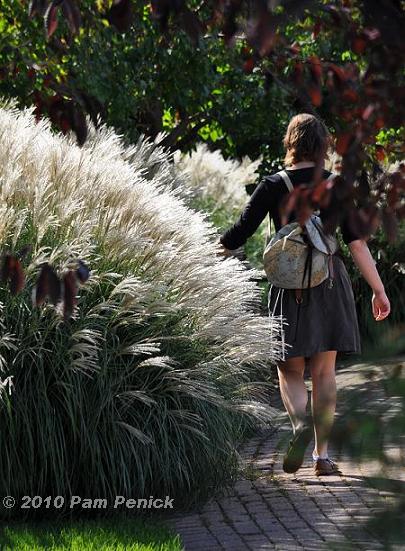
How I need to work on my paths. Observation here: All of these wonderful paths seem to be on flat ground. I garden on slopes and hills. Any suggestions?
Hi, Darla. One of the pictures is of my hillside path; more about its construction can be found on this how-to post about it. —Pam
Thoughtful post and this reminds me that we have one more path to go. Down the left side of the house. Right now it is just a worn track in the grass.
I still have a few to go myself, Jenny. Rome wasn’t built in a day, right? —Pam
Great post and photos. Once I complete the pathways on the sides of my house and prairies, I will have a closed circuit garden.
I’m still working on that myself, Bluestem. My next project, I hope, is to complete front-yard paths to the side gates. —Pam
Your paths are outstanding with the various materials that you use. Most of the paths in my garden are grass. I have one that is pea gravel. All of the most defined paths are in the back of the house or sides. I really need to do something in the front garden though. These photos give me lots of inspiration.
Thanks, Lisa. Most of these pictures, as I’m sure you know, are not of my garden but ones I’ve visited and admired. I do try to include various path materials in my own garden to keep things interesting—and because I often use what’s on hand. I probably gave short shrift to grass paths, which can be quite effective in cooler climates than mine. I admired a lovely grass path in Seattle this summer. —Pam
Thanks.
You’re welcome! —Pam
This is an interesting look at how people move, or are willing to move, through a space. Seems gravel only works well with some people if there is edging (hard surfaces, esp with plant reinforcement of the direction) and/or there is a focal point along an axis. Here, gravel is treated as a lawn…and flagstone pieces in gravel help many “see the way”, but to me are usually horrid. Thought-provoking post!
I’m glad you mentioned how gravel is used in desert gardens, David. You are right—how people use path materials can differ greatly in various regions. I realized, in answer to an earlier comment, that grass paths can be very effective in cooler, wetter regions than mine. And now I’m wondering what great paths look like in your region (Albuquerque). More food for thought! —Pam
I love how you tackled the concept of movement through the garden – something that’s quite often overlooked. And your last point is the best – take the time to actually walk down your paths! Lovely, Pam.
The pleasure of strolling a garden path is greater than that of kicking back on a garden bench, in my opinion. I’m sure most gardeners would agree—the fun and excitement is in getting in there to see what’s happening. Thanks for backing me up, Rebecca! —Pam
Pam, I really appreciate your practical approach to creating functional passageways around the garden. And I love that third pic of the cobbled-together walkway–there’s something about using a variety of materials in a path or a wall that makes it really interesting and charming!
Thanks, Jenny. Yes, practicality first, and then bring in the artistry. That cobbled path (not the 3rd picture but the 5th, right?) illustrates this idea beautifully. —Pam
Cool paths and good tips – form follows function – I like all of them. I look forward to sitting down and reading the other GDR posts as I’ve been looking forward to this topic – but that’ll be later today, after I’ve planted a Potatorum / butterfly agave in a culvert pipe (15 gallon. succulents are half off at Lowes on Steck!) ….just thought you would approve. : )
Oh, I heartily approve of your agave-in-culvert-pipe plan, Cyndi! I’ll hope you’ll share a picture with me on Facebook when you’re done. One heads-up though: I’m not sure that Agave potatorum is dependably winter-hardy in Austin, especially in a planter where it will be more exposed. You might need to give it some protection during hard freezes, or switch it out into a pot you can easily bring indoors as needed. For a thoroughly cold-hardy succulent, try a yucca like ‘Color Guard’ or ‘Bright Edge.’ —Pam
Thanks, Pam! Great post that’s almost a free course in garden design. 🙂 I now have about 1/2 acre of house/cottage/greenhouse/dead grass/abandoned landscape to revive, with three gates, two sidewalks going almost nowhere, and visitors who always come through the private garden area to the back door instead of the front! Now I have some solid ideas for designing a pathway that circulates around the property and by the nine (at least) different gardening areas I have to deal with. Whew!
Happy trails from Leander and Taylor,
bobbi c.
It sounds like you have your work cut out for you, Bobbi, but the process (not the destination) is really the fun part anyway. A wide, welcoming front walk will make all the difference for you, I bet, in getting visitors to come to the front door instead of the back. —Pam
Great tips Pam! Love the Cedar(?) screen in pic #7, functional and easy on the eyes, and I agree with Rebecca, Tip #7 sums it all up, experience the garden on your paths. Excellent!
Thanks, Scott. If you’d like more info on construction of my cedar screen, check out this link. —Pam
Gorgeous photos as usual Pam! It really makes me think about all of my path options more now. I really have to get crackin on some better paths at my own house! Thank you for the lovely inspiration. 🙂
My pleasure, Christina. And believe me, I still have work to do on my own garden paths. The will is there. Now I just need the budget. 😉 —Pam
These are all really good tips, and some great photos, about garden paths. Thanks!
I’m glad you found them useful, Alison. Thanks for your comment. —Pam
nicely done pam. love the last image of the walking path along the grasses.
Thanks, Andrea. That last image is from Olbrich Botanical Gardens in Madison, Wisconsin, last fall. —Pam
Hi Pam, wonderful, thoughtful, useful post! I especially love the Closed Circuit tip. Of course, I know it intuitively, but no one has ever so simply explained this important design concept. I am taking good notes for my next path project!
thank you, Debra
And thank YOU, Debra, for writing such an interesting, thought-provoking post as guests of Garden Designers Roundtable this month. I hope everyone will click over to your site to read it. —Pam
Yes, I love all that you say about the function and architecture of the journey and the pay offs you outline that result from such good design. This it seems to me is the essence of what we are about!
Best
R
Emotional and visually stunning pay-offs are what we strive for, right, Robert? —Pam
Pam, I like that you talk about how paths are used for different purposes; that helps me think about how wide, open, straight, and obvious to make a path. Maybe a main path would be more direct and inviting, and a tangential path more winding and mysterious, and a working/weeding path more hidden. There are so many possible materials and designs (and routes!), but now I have a way to narrow it down a bit. Thanks for the thought-provoking post.
Thank you for your thoughtful comment, Evelyn. I’m glad you enjoyed the post. —Pam
form follows function. but, it’s good when they both work together. Nice post.
Thanks, Greggo. Paths are one of those things in the garden that can really meld function and beauty. —Pam
Great article, Pam. Practical and beautiful at the same time.
Many thanks, Carolyn Gail! —Pam
Good information and particularly wonderful photos! They really show what a difference a well-thought out pathway can make.
Thanks, Susan. And now’s a great time of year to be thinking out new paths. —Pam
I am a big fan of the “form follows function” edict, and love the way you’ve used it to present an incredible amount of helpful information here. Wonderfully inspiring, Pam!!
I’m glad you think so, Jocelyn. Thanks! —Pam
GREAT post. Thank you! When 14 years ago, we put in the huge (for us) lawn that I now hate and my husband won’t let go of, I INSISTED on a path going out to the canyon edge saying that no one would leave our patio and walk out there if we didn’t invite them to do so by showing them a way. (I used the exact words you did “invite them.”) And now, when friends come over, especially men, after a few words standing on the patio, they make a beeline for the path and the canyon edge and stand out there looking and talking. Funny thing is, my two dogs use the path a LOT, too! Especially the day before the lawn is mowed where there has been dew over night. They are low-to-the-ground corgis!
Fantastic, Melissa. Paths make all the difference in how we experience a garden or landscape. And it’s funny about the dogs using the path too. I bet they like to keep their feet and bellies dry too! —Pam
Just found this – Thank you for the ideas! We have a mushy, early spring lawn right now (in OR) and I was looking for options to defeat the mud puddle that invariably appears at the base of the deck stairs and a path over to the patio. Eventually, Hubby will get an additional stairway added for more direct access but until then… Plus, we will soon have additional storage with exterior access that will also need a path. So many choices! I can hardly wait to finish the plans!